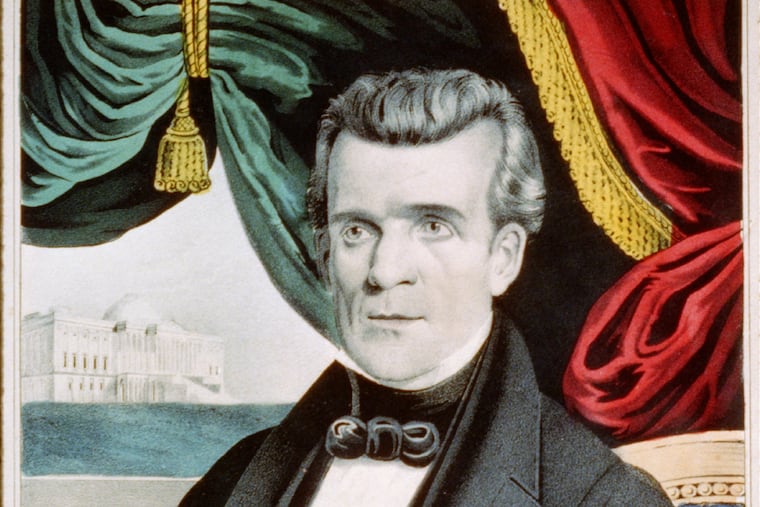Medical mystery: A president, an epidemic, and grand tour cut short
The one-term president, under whom the country expanded to the Pacific, embarked on a goodwill tour of the South after leaving office.

James K. Polk, often referred to as the first “dark horse” candidate for U.S. president, ascended to the White House in 1845 at age 49, the youngest elected up to that date. The former congressman, the nation’s 11th chief executive, was a Jacksonian Democrat from Tennessee and nicknamed “Young Hickory” in a nod to “Old Hickory” Andrew Jackson, the seventh president.
During Polk’s single four-year term, the United States greatly expanded its territory, adding more than a million square miles, including present-day California, Washington and Texas. Although many thought he could have easily been reelected, Polk kept his campaign promise to serve only one term and retired from the presidency, turning it over to Zachary Taylor on March 4, 1849. Some indicated that the stress of the nation’s highest office had left Polk in poor health.
On March 6, James and Sarah Polk embarked on a grand tour of the Southern states, from Washington, down the Atlantic seaboard, west along the Gulf states of Alabama and Mississippi, to New Orleans in Louisiana, and then up the Mississippi River to his home state of Tennessee. Everywhere Polk traveled, the crowds were large and festive.
A devastating gastrointestinal illness had hit New Orleans the winter of 1848-49, prompting the New Orleans Medical Board to announce that “disease invaded the levee like an avalanche." Polk reportedly heard rumors of the illness -- and already was suffering from a severe cold -- but stayed in the city, bowled over by the hospitality he received there.
As Polk left New Orleans, he began to experience acute abdominal distress and later diarrhea, vomiting and dehydration. He developed increasing weakness and dizziness that worsened when standing. Extreme fatigue and severe bouts of watery diarrhea as he traveled up the Mississippi River caused Polk to cut short his trip and head to Memphis, then go by horse and carriage to his home in Nashville.
His symptoms persisted as he arrived at his recently purchased mansion, named “Polk Place," where he planned to sort through his presidential papers. But the gastrointestinal illness took its toll, and Polk continued to fail.
Solution
There is clear evidence that a cholera epidemic entered the United States at two separate locations within a nine-day period, probably by ship: New York on Dec. 2, 1848, and New Orleans on Dec. 11, 1848. The disease spread rapidly through interior waterways and along the Atlantic seaboard.
Cholera is caused by strains of the bacterium Vibrio cholerae infecting the small intestine. It is spread mostly by contaminated water and raw or undercooked seafood that has been contaminated with human feces containing the bacteria.
GI symptoms range from mild to severe, with some infected patients having no symptoms. The classic patient has large amounts of watery diarrhea lasting a few days accompanied by vomiting and muscle cramps. Diarrhea can be quite severe, leading to dehydration, acidosis, and potassium and sodium imbalance. Symptoms can start as early as two hours after exposure or up to five days later. The patient may develop wrinkled, cold, bluish skin of the face, hands and feet, and sunken eyes.
With the advent of modern sanitary sewer systems and water supplies, cholera is a threat mainly in the developing world, especially in the aftermath of natural disasters. Fortunately, antibiotic treatment, as well as oral rehydration therapy and intravenous fluid and electrolytes, for the more severely ill, mean that cholera is not nearly as deadly as it once was.
Poor sanitation, not enough clean drinking water, and poverty are risk factors. Some scientists fear that rising sea levels will increase future rates of cholera. For those in high-risk areas, a vaccine given by mouth provides reasonable protection for roughly six to 24 months.
James Polk died on June 15, 1849, just three months after leaving the White House. In keeping with Nashville city laws to prevent infectious diseases from spreading, his body was buried for a year in a mass grave in the Nashville City Cemetery. Then his relatives moved his body to Polk Place. The family sold the land, and the bodies of James and Sarah Polk were relocated to the former Polk home in Columbia, Tenn., which became the James K. Polk Museum.
For his vast expansion of territory to the Pacific, Polk has been recognized in the list of best one-term U.S. presidents.
Just five years after Polk’s death, a cholera outbreak in London’s Soho District was stopped when a physician, John Snow, traced its source to contaminated water, specifically a water pump on what then was Broad Street. Before Snow’s work, the disease was thought to spread through the air, or “miasma.” Today, Snow is considered a father of modern epidemiology.